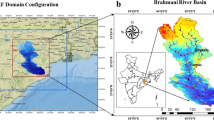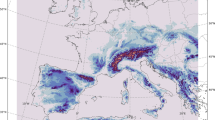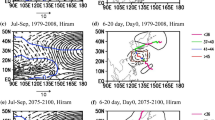Abstract
The atmospheric haze over the Pearl River Delta (PRD) was investigated by using the Models-3 Community Multi-scale Air Quality modeling system with meteorological fields simulated by the Fifth-generation National Center for Atmospheric Research/Penn State University Mesoscale Model (MM5) from September 26th to September 30th, 2004. The model-simulated meteorological elements and particulate matter with aerodynamic diameter less than 10 μm (PM10) were compared with observations at four air quality-monitoring stations. The results showed that MM5 successfully reproduced the diurnal variations of temperature, wind speed, and wind directions at these stations. The temporal variations of the simulated values were consistent with those of the observed (such as temperature, wind speed, and wind direction). The correlation coefficient was 0.91 for temperature and 0.56 for wind speed. The modeling results show that the spatial distributions of simulated PM10 were closely related to the source emissions indicating three maxima of PM10 over the PRD. The sea–land breezes diurnal cycle played a significant role in the redistribution and transport of PM10. Nighttime land breeze could transport PM10 to the coast and the sea, while daytime sea breeze (SB) could carry the accumulated PM10 offshore back to the inland cities. PM10 could also be transported vertically to a height of up to about 1000 m because of strong turbulence in the SB front. Process analyses indicated that the emission sources and the vertical diffusion were the major processes to influence the concentrations of particulate matter with aerodynamic diameter less than 2.5 μm (PM2.5).










Similar content being viewed by others
References
Barna, M., & Lamb, B. (2000). Improving ozone modeling in regions of complex terrain using observational nudging in a prognostic meteorological model. Atmospheric Environment, 34, 4889–4906.
Byun, D. W., & Ching, J. K. S. (1999). Science algorithms of the EPA Models-3 Community Multi-scale Air Quality (CMAQ) modeling system. Rep. USA EPA/600/R-99/030. Washington, DC: Environmental Protection Agency.
Charron, A., & Harrison, R. M. (2005). Fine (PM2.5) and coarse (PM2.5–10) particulate matter on a heavily trafficked London highway: Sources and process. Environmental Science and Technology, 39, 7768–7776.
Cheng, W. L. (2002). Ozone distribution in coastal central Taiwan under sea-breeze conditions. Atmospheric Environment, 36, 3445–3459.
Dennis, R. L., Byun, D. W., Novak, J. H., Galluppi, K. J., Coats, C. J., & Vouk, M. A. (1996). The next generation of integrated air quality models: EPA’s Models-3. Atmospheric Environment, 30, 1925–1938.
Ding, A. J., Wang, T., Zhao, M., Wang, T. J., & Li, Z. K. (2004). Simulation of sea–land breezes and a discussion of their implications on the transport of air pollution during a multi-day ozone episode in the Pearl River Delta of China. Atmospheric Environment, 38, 6737–6750.
Dockery, W. D., Cunningham, J., Damokosh, A. I., Neas, L. M., Spengler, J. D., Koutrakis, P., et al. (1996). Health effects of acid aerosols on North American children: Respiratory symptoms. Environmental Health Perspectives, 104, 500–505.
Environmental Protection Department (2005) HKSAR, 2005, air quality in Hong Kong. Available at: http://www.epd.gov.hk/epd/english/envionmentinhk/air/air_quality/files/aqr04c.pdf.
Feng, Y. R., Wang, A. Y., Wu, D., & Xu, X. D. (2007). The influence of tropical cyclone Melor on PM10 concentrations during an aerosol episode over the Pearl River Delta region of China: Numerical modeling versus observational analysis. Atmospheric Environment, 41, 4349–4365.
Fung, J. C. H., Lau, A. K. H., Lam, J. S. L., & Yuan, Z. (2005). Observational and modeling analysis of a severe air pollution episode in western Hong Kong. Journal of Geophysical Research, 110, D09105, DOI 10.1029/2004JD005105.
Grell, G. A., Dudhia, J., & Stauffer, D. R. (1994). A description in the fifth generation PSU/NCAR mesoscale model(MM5), NCAR Tech, Note, NCAR/TN, 398+STR, 138.
Hong, S. Y., & Pan, H. L. (1996). Nonlocal boundary layer vertical diffusion in a medium-range forecast model. Monthly Weather Review, 124, 2322–2339.
Houyoux, M., Vukovich, J., Brandmeyer, J. E., Seppanen, C., & Holland, A. (2004). SMOKE user manual version 2.1. Chapel Hill, NC: Carolina Environmental Program (October).
Husar, R. B., Prospero, J. M., & Stowe, L. L. (1997). Characterization of tropospheric aerosols over the oceans with the NOM advanced very high resolution radiometer optical thickness operational product. Journal of Geophysical Research, 102, 16889–16909.
Jang, J. C., Jeffries, H. E., Byun, D., & Pleim, J. E. (1995a). Sensitivity of ozone to model grid resolution.I: Application of high-resolution regional acid deposition model. Atmospheric Environment, 29, 3085–3100.
Jang, J. C., Jeffries, H. E., & Tonnesen, S. (1995b). Sensitivity of ozone to model grid resolution. II: Detailed process analysis for ozone chemistry. Atmospheric Environment, 29, 3101–3114.
Jeffries, H. E., & Tonnesen, S. (1994). A comparison of two photochemical reaction mechanisms using a mass balance and process analysis. Atmospheric Environment, 28, 2991–3003.
Kain, J. S., & Fritsch, J. M. (1993). Convective parameterization for mesoscale models: The Kain–Fritsch scheme. The representation of cumulus in numerical models. In K. A. Emanuel, & D. J. Raymond (Eds.) Meteorological monographs of the American Meteorological Society (pp. 165–170). Boston, MA: American Meteorological Society.
Kambezidis, H. D., Weidauer, D., Melas, D., & Ulbricht, M. (1998). Air quality in the Athens Basin during sea breeze and no-sea breeze days using laser-remote-sensing technique. Atmospheric Environment, 32, 2173–2182.
Kitada, T., & Kitagawa, E. (1990). Numerical analysis of the role of sea breeze fronts on air quality in coastal and inland polluted areas. Atmospheric Environment, 24A, 1545–1559.
Lee, Y. L., & Sequeira, R. (2001). Visibility degradation across Hong Kong: Its components and their relative contributions. Atmospheric Environment, 34, 5861–5872.
Liu, H. P., & Chan, J. C. L. (2002a). An investigation of air-pollutant patterns under sea–land breezes during a severe air-pollution episode in Hong Kong. Atmospheric Environment, 36, 591–601.
Liu, H. P., & Chan, J. C. L. (2002b). Boundary layer dynamics associated with a severe air pollution episode in Hong Kong. Atmospheric Environment, 36, 2013–2025.
Liu, Y., Wang, M. X., & Zhang, R. J. (1999). The present status of aerosol research in China. Climatic and Environmental Research, 4, 406–414.
Liu, Y., Zhang, D. L., & Yau, M. K. (1997). A multiscale numerical study of Hurricane Andrew (1992). Part I: Explicit simulation and verification. Monthly Weather Review, 125, 3073–3093.
Macao Geophysical and Meteorological Bureau (2004). Monthly result of air quality. Available at: http://www.smg.gov.mo/ccaa.reprot/pdf/IQA_M/IQA_200409.pdf (34pp, in Chinese).
Seaman, N. L., Stauffer, D. R., & Lario-Gibbs, A. M. (1995). A multiscale four-dimensional data assimilation system applied in the San Joaquin valley during SARMAP Part I: Modeling design and basic performance characteristics. Journal of Applied Meteorology, 34, 1739–1761.
Srinivas, C. V., Venkatesan, R., & Bagavath Singh, A. (2007). Sensitivity of mesoscale simulations of land-sea breeze to boundary layer turbulence parameterization. Atmospheric Environment, 41, 2534–2548.
Stauffer, D. R., & Seaman, N. L. (1990). Use of four-dimensional data assimilations in a limited-area mesoscale model Part I: Experiments with synoptic-scale data. Monthly Weather Review, 118, 1250–1277.
Stauffer, D. R., & Seaman, N. L. (1991). Use of four-dimensional data assimilations in a limited-area mesoscale model Part II: Effects of data assimilation within the planetary boundary layer. Monthly Weather Review, 119, 734–754.
Stauffer, D. R., & Seaman, N. L. (1994). Multiscale four-dimensional data assimilation. Journal of Applied Meteorology, 33, 416–434.
Streets, D. G., Bond, T. C., Carmichael, G. R., Fernandes, S. D., Fu, Q., He, D., et al. (2003). An inventory of gaseous and primary aerosol emission in Asia in the year 2000. Journal of Geophysical Research, 108(D21), 8809, DOI 10.1029/2002JD003093.
Streets, D. G., & Waldhoff, S. T. (2000). Present and future emissions of air pollutants in China: SO2, NOx and CO. Atmospheric Environment, 34, 363–374.
US Environment Protection Agency (2003). User’s guide to MOBILE6.1 and MOBILE6.2. EPA Office of Air and Radiation, EPA420-R-03-010. Washington, DC: Assessment and Standards Division, Office of Transportation and Air Quality, US EPA (262pp).
Wang, X., Carmichael, G., Chen, D., Tang, Y., & Wang, T. (2005). Impacts of different emission sources on air quality during March 2001 in the Pearl River Delta (PRD) region. Atmospheric Environment, 39, 5227–5241.
Wang, X., Mauzerall, D. L., Hu, Y., Russell, A. G., Woo, J., & Streets, D. G. (2003). Evaluating the impact of air pollution on Human health in China: The price of clean air. Eos Transactions, AGU, vol. 84, no. 46, Fall meeting supplement, Abstract U31D-03.
Wang, T., Wu, Y. Y., Cheung, T. F., & Lam, K. S. (2001). A study of surface ozone and the relation to complex wind flow in Hong Kong. Atmospheric Environment, 35, 3203–3215.
Weisman, M. L., Skamarock, W. C., & Klemp, J. B. (1997). The resolution dependence of explicitly modeled convection systems. Monthly Weather Review, 125, 527–548.
Wu, D., Tie, X. X., Li, C. C., Ying, Z. M., Lau, A. K. H., Huang, J., et al. (2005). An extremely low visibility event over the Guangzhou region: A case study. Atmospheric Environment, 39, 6568–6577.
Yu, S., Eder, B., Dennis, R., Chu, S. H., & Schwariz, S. (2005). On the development of new metrics for the evaluation of air quality models. Atmospheric Science Letters, 7, 26–34.
Zhao, B. X. (2003). Study on the effect of PM10 and SO2 air pollution on children’s pulmonary function in Taiyuan city, China. Journal of Labour Medicine, 20, 203–206.
Acknowledgments
This research was supported by the National Hi-Tech Research and Development Program of China (the 863-Program; no. 2006AA12Z207), a Hong Kong RGC grant (reference no. CUHK 447807), and the National Key Program for Developing Basic Research (the 973-Program; no. 2002CB410801). The authors thank the Hong Kong University of Science and Technology for making the graphic data available through the internet (http://ccar.ust.hk/). These data include massive observations of air pollutants and meteorological data. Gratitude is also extended to the Hong Kong Environmental Protection Agency, The City University of Hong Kong, Macao Geophysical and Meteorological Bureau, Guangdong Provincial Environmental Protection Bureau, and Guangzhou Municipal Environmental Protection Bureau for providing concentrations data and emission inventories. These data greatly facilitated our work.
Author information
Authors and Affiliations
Corresponding author
Rights and permissions
About this article
Cite this article
Xun-lai, C., Ye-rong, F., Jiang-nan, L. et al. Numerical Simulations on the Effect of Sea–Land Breezes on Atmospheric Haze over the Pearl River Delta Region. Environ Model Assess 14, 351–363 (2009). https://doi.org/10.1007/s10666-007-9131-5
Received:
Accepted:
Published:
Issue Date:
DOI: https://doi.org/10.1007/s10666-007-9131-5




